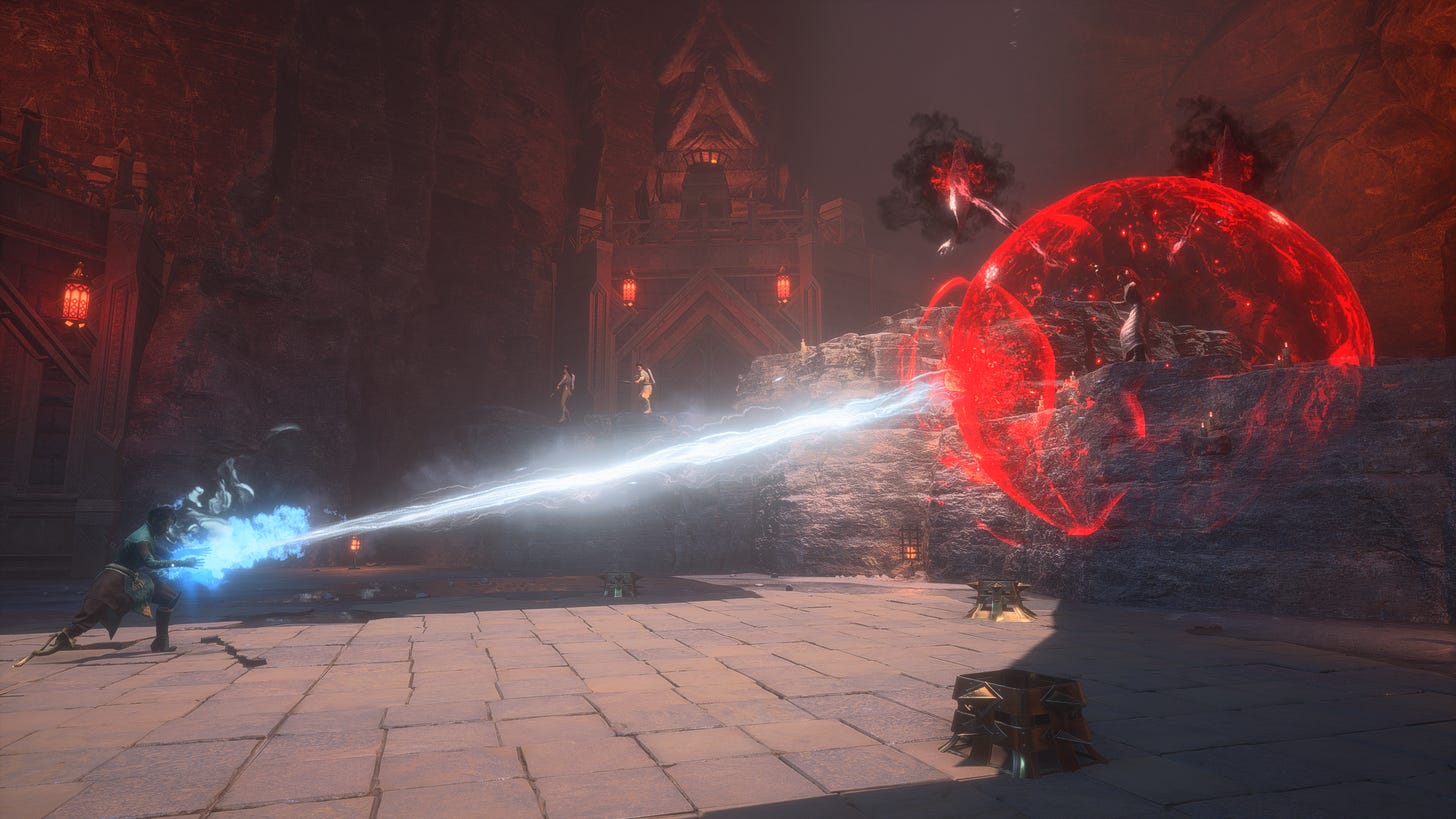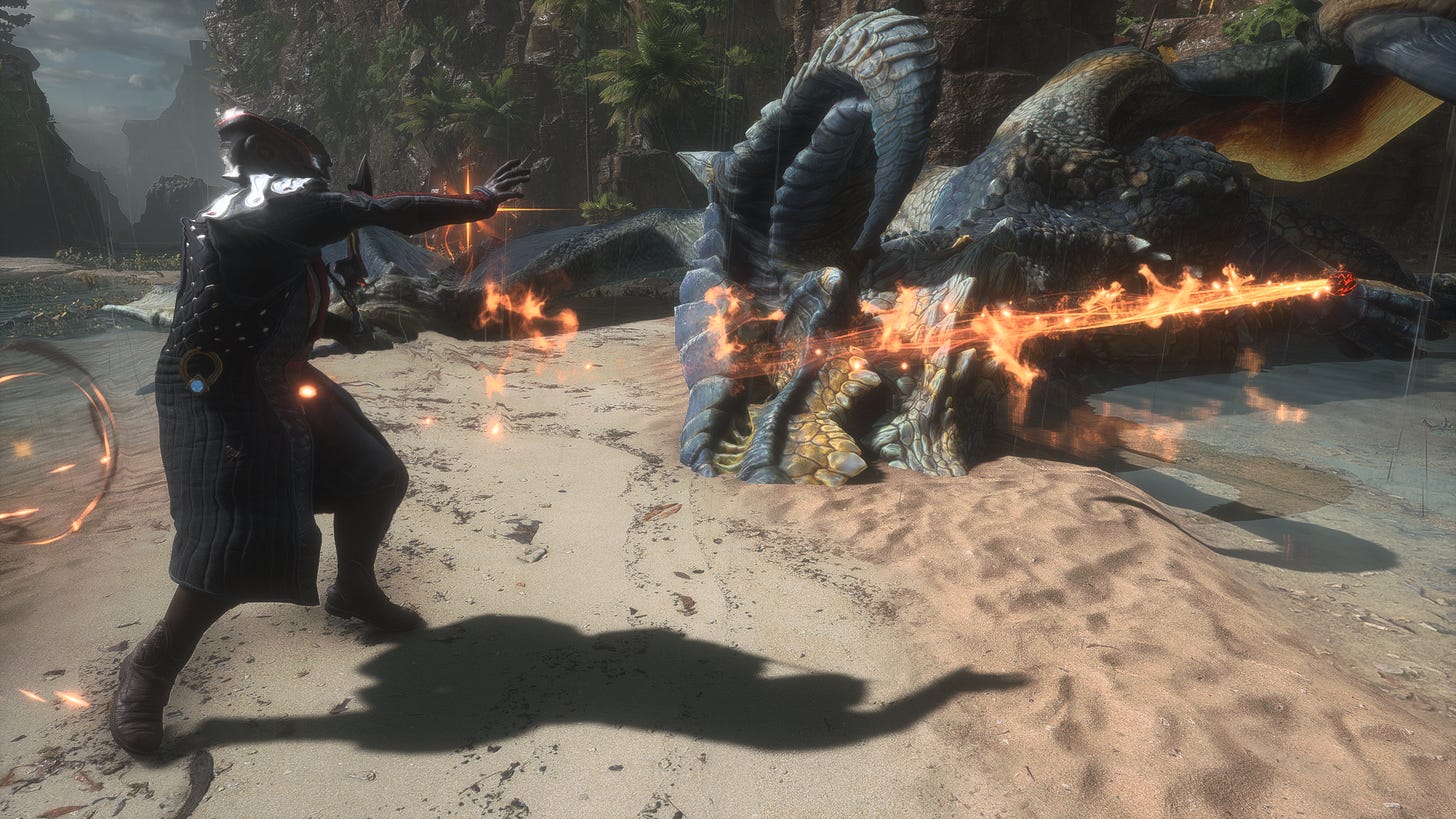Dragon Age: The Veilguard is well worth the 10-year wait
The BioWare series returns to life in a very different form... and does so with great aplomb
Review | Dragon Age: The Veilguard
Developed by BioWare and published by Electronic Arts
Rating: ★★★★★★★★☆☆
It’s been a decade since the RPG franchise’s last outing, Dragon Age: Inquisition, but it feels like just yesterday that I was riding through the Storm Coast with my crew, braving blustery winds and Hurlocks alike. The game wasn’t perfect by any means — hell, I’d describe the grind and repetitiveness of some of its areas as a major drawback. But it was fun, had a great story and perhaps most importantly, felt like a proper Dragon Age game again after the… conceptual detour (to put it politely) that was Dragon Age II. Flash-forward to 2024 and all sorts of questions had been raised about the forthcoming Dragon Age: The Veilguard. What would the gameplay be like? What would the story be? Would the game be faithful to its source material? Why on earth did they change the name from the admittedly cooler Dragon Age: Dreadwolf? And so on.
All of these thoughts swirled around inside my head as I set the fourth instalment in the Dragon Age series to download. Sure, I had my concerns, but there wasn’t the sliver of a chance that I wasn’t going to play it. After all, the game belongs to a series that’s had such a profound impact on me that I saw fit to name this very publication after a key part of Dragon Age mythology.
October 31 saw the launch of Dragon Age: The Veilguard, a decidedly single-player experience (with BioWare having long since cast aside its apparently multiplayer/live-service plans for the title) that takes place a little while after the events of Inquisition. For those not in the know, you played the Inquisitor in the previous game, leading a motley crew that included soldiers, mages, an assassin, a diplomat and so on. Your mission? To take down Corypheus, an ancient darkspawn1 mage, close the breach between the physical and spirit worlds and restore order to the world.
With The Veilguard, and in the typical style of the series, you kick things off with a new protagonist — an almost-blank slate with a few background presets from which to build your character’s origins. A rich customisation suite means you can get your version of Rook, our protagonist this time out, as close to (or far from) a real avatar of yourself as possible. On a side note: I should point out that the hair physics in The Veilguard (even though you can’t see them in the image below) are the best I’ve seen in any videogame. In 2001, the film Final Fantasy: The Spirits Within changed public perceptions of what animated hair could look like. Over 23 years later, the latest chapter of Dragon Age does just that.
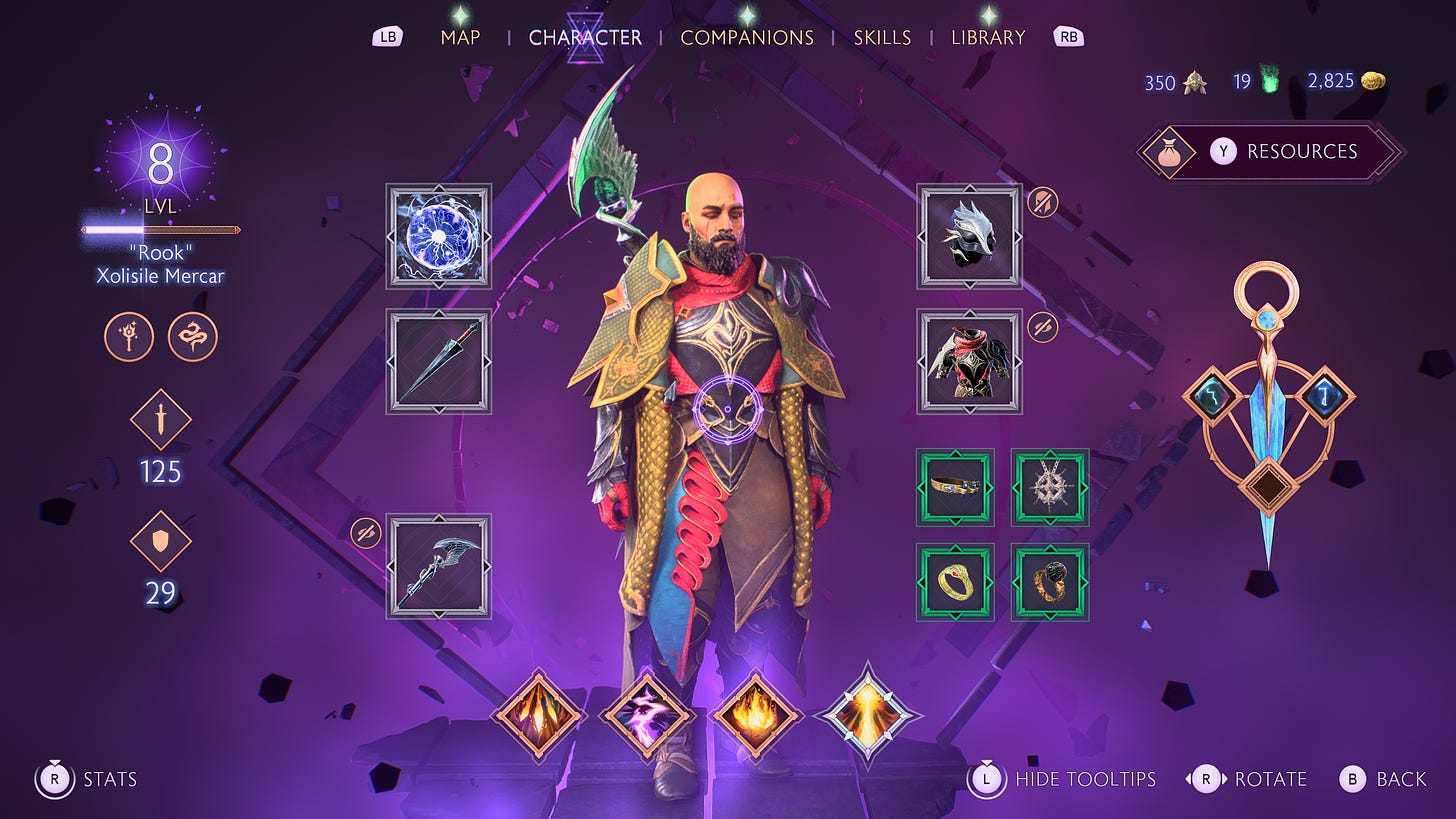
The big picture
Much as with the two previous outings, The Veilguard starts you off in a place of familiarity — a conversation with pivotal Dragon Age II and Inquisition character Varric Tethras (Inquisition also kicked off with Varric and Dragon Age II featured returning character Flemeth in the opening section). This attempt at orienting the player in a new setting using a familiar character remains effective, especially considering The Veilguard not only features a new world with new characters and factions, but also represents a new identity for the series. We’ll get into all of that in a bit more depth in good time. For now, I want to focus on the big picture… as the subhead succinctly states.
It hits you very early on that the format has been altered. I wouldn’t necessarily call it an evolution or devolution, but what you knew to be Dragon Age isn’t what you’ll find on The Veilguard. For starters, there’s the visual aesthetic of the game that leans in a more cartoony and less realistic direction than in previous titles. Then, there’s the realisation that you’re only allowed to take two companions on your adventures — you used to be able to take three. Next, there’s the combat which is no longer D&D-inspired, turn-based fare; instead, it’s almost entirely action-oriented. And finally, it’s no longer an open-world game — The Veilguard is an interconnected set of open areas.
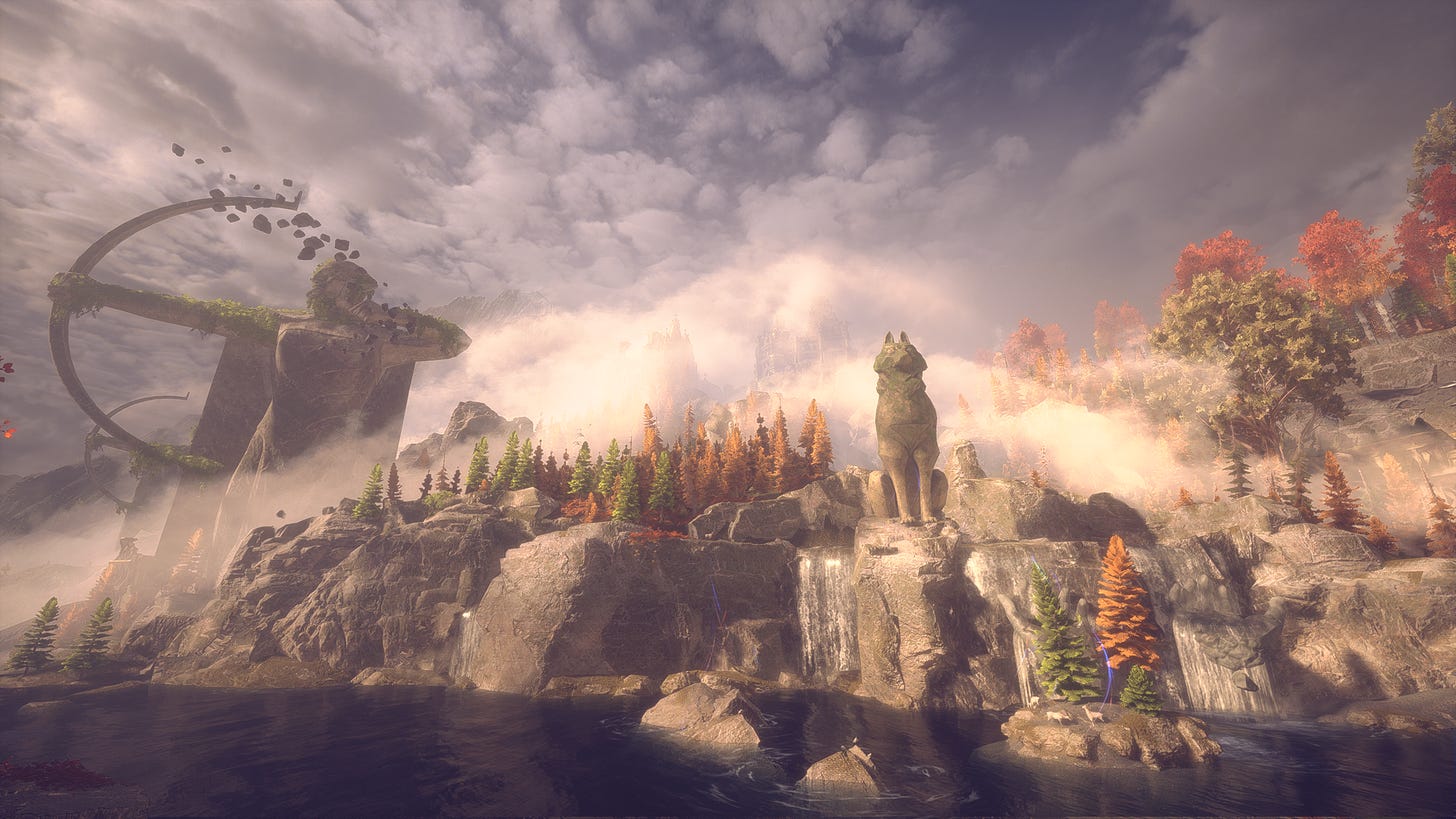
What the last point means is that even though this game takes place across a far larger chunk of land than previous games, the experience is packed into smaller areas than before. For context, while the Dragon Age games thus far have been set in the southern parts of the fictional landmass of Thedas2 — Dragon Age: Origins in Ferelden, Dragon Age II in Kirkwall, Inquisition was in Orlais and Ferelden — The Veilguard takes matters to the northern half of the continent. Covered with cities, forests, swamps and stormy seasides, the game’s playing field certainly kept me engaged during my 60-hour run.
So with these alterations (and a few others I’ve yet to reference) in place, what did it mean for my experience with The Veilguard? Most pertinently, a number of these changes contributed greatly to the game’s linear and narrative-focussed approach that was alluded to by the developers pre-launch. In many ways, I saw the game as conceptually more akin to the second and third Mass Effect games (space operas, also made by BioWare) than the previous Dragon Age games. Those were also games that had eschewed in-depth RPG mechanics (not limited to being able to engage in detailed crafting and the ability to intricately tweaking your teammates’ stats and attire) for a tighter and more action-focused experience.
I also found the game’s fundamental framework to be very similar to that of Mass Effect 2 and 3, in that you are initially tasked with assembling a team with earmarked recruits, then winning their confidence through a series of The Veilguard’s equivalent of ‘loyalty missions’3, and finally leading them into a series of quests with a low chance of success. The level of loyalty and the characters’ respective suitability for specific tasks will determine if they live or die. We’ve seen this idea implemented quite well in the aforementioned Mass Effect games, and in a high-fantasy setting, the formula works equally well. I thoroughly enjoyed exploring the diverse set of personal struggles with which each of my companions was grappling, as well as resolving them. Interspersed with the major plot beats and the entertaining selection of side quests (while not quite as engrossing as those in The Witcher 3: The Wild Hunt, I should add), these missions kept proceedings fresh and quite engaging.
The shift in combat style — the usual light attack, heavy attack, dodge and jump matrix of commands — didn’t take me as long to come to grips with (maybe ‘come to terms with’ is more accurate here) as the game’s refusal to let me direct my companions to different parts of the scene. In previous games, this ability was handy when solving puzzles, being more strategic in combat or avoiding setting off traps with the main character. But with the team size down to three (Rook included) and the game only allowing you to pick combat options and targets, this is where the streamlined nature of The Veilguard is most palpable. Like I said above, I got used to it until it became second nature, but I wasn’t too fond of this particular alteration, particularly since having only two companions served to limit my combat strategy.
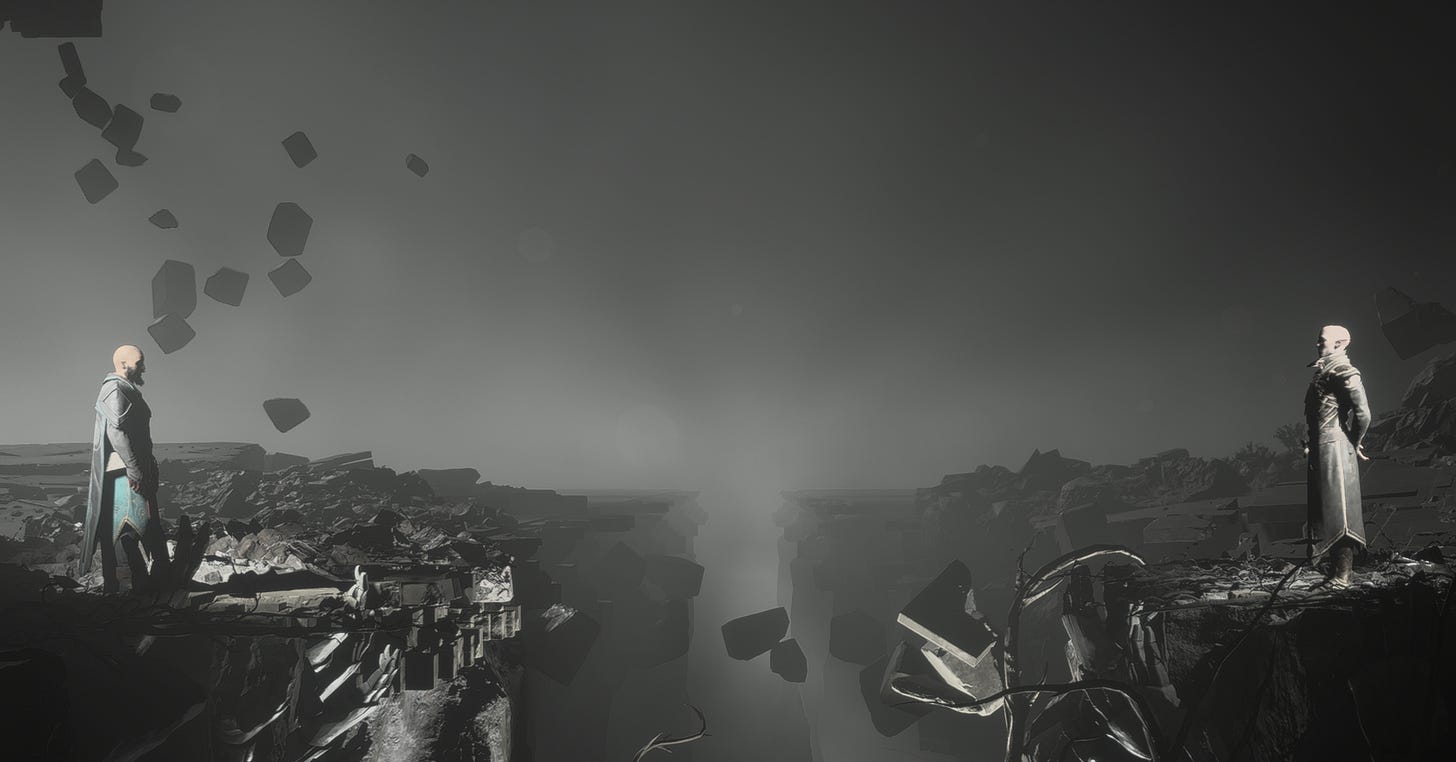
And that brings us to the premise, something that I’d been looking forward to since the time I completed Inquisition and discovered the treachery of Solas — a key member of the Inquisition and one of my frequently-deployed companions in that game. At the very end of the game, the apostate mage Solas reveals he is actually Fen'Harel, the Elven god also known as the Dreadwolf. And he’s got a whole other agenda, unbeknownst to the Inquisitor and gang. The Veilguard’s biggest draw was that it offered the opportunity to learn more about his nefarious schemes and stop them dead in their tracks. However, things take a turn when the effort to thwart Solas ends up unleashing two other gods instead, who are far more malevolent than the Dreadwolf. The latter, since you were wondering, finds himself imprisoned in the Fade4, and goes from adversary to advisor in Rook’s effort to take down the two other gods.
Overall, the story was logical, well-paced and yes, extremely focussed and linear; it also contributed richly to filling out the various kingdoms of northern Thedas with interesting and compelling quests. The cast of varied characters had me invested, and I enjoyed having them lead me on a journey that went beyond simply tracking down and killing two rogue gods. All of this was aided by gorgeous areas ranging from the busy Dock Town and sludgy Hossberg Wetlands, to the magical Arlathan Forest and the haunting Nevarra where the undead roam. I enjoyed exploring each of the different sections not only because they looked incredible, but also because they sported intuitive level design — the sort that invited me to explore and check out nooks and crannies even when it wasn’t demanded by any quest.
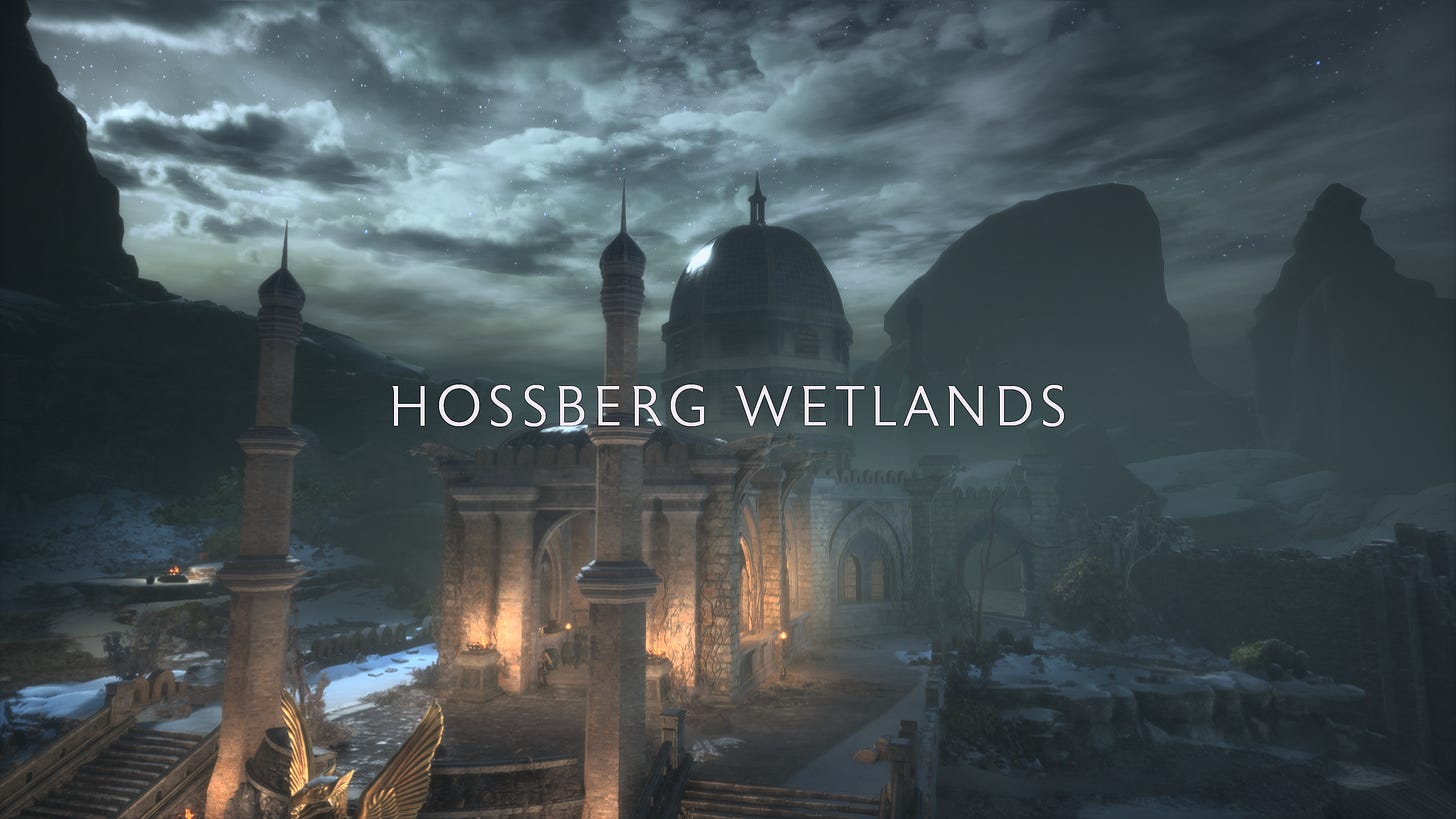
The finer details
Among the more notable aspects of The Veilguard was that it shipped in near-perfect conditions. This should be the norm and I shouldn’t even have to write about it, but as it stands, it is a rarity with AAA games these days. Still, I found the absence of bugs, glitches, crashes and the lot quite refreshing. Elsewhere and equally refreshing was the return of full-fledged and thoroughly fleshed-out codices in RPGs. Certainly, BioWare has always packed its RPGs with lore in the form of in-game information or copious amounts of literature that forms the codices. And I was glad to see that while the studio was changing the DNA of Dragon Age in numerous ways, this was something that was retained.
It might be a case of overstating the point, but it feels important to underscore just how important it is to have a robust codex system. And it all comes down to one thing: Choice. Players need to be able to choose how much information they wish to engage with when they’re immersing themselves in a world. In recent times, I’ve been frustrated by games that provide minimal information or background context to certain actions, events or characters — especially when it would have hugely influenced my levels of investment in them. At the same time, I find myself feeling smothered by other games that seek to bury me under exposition regardless of whether or not I sought it. That’s where codices come in: To provide information and context, as much or as little of it whenever you desire. Plus, given that this is the fourth entry in the series, there’s plenty of background on which you may want to catch up.
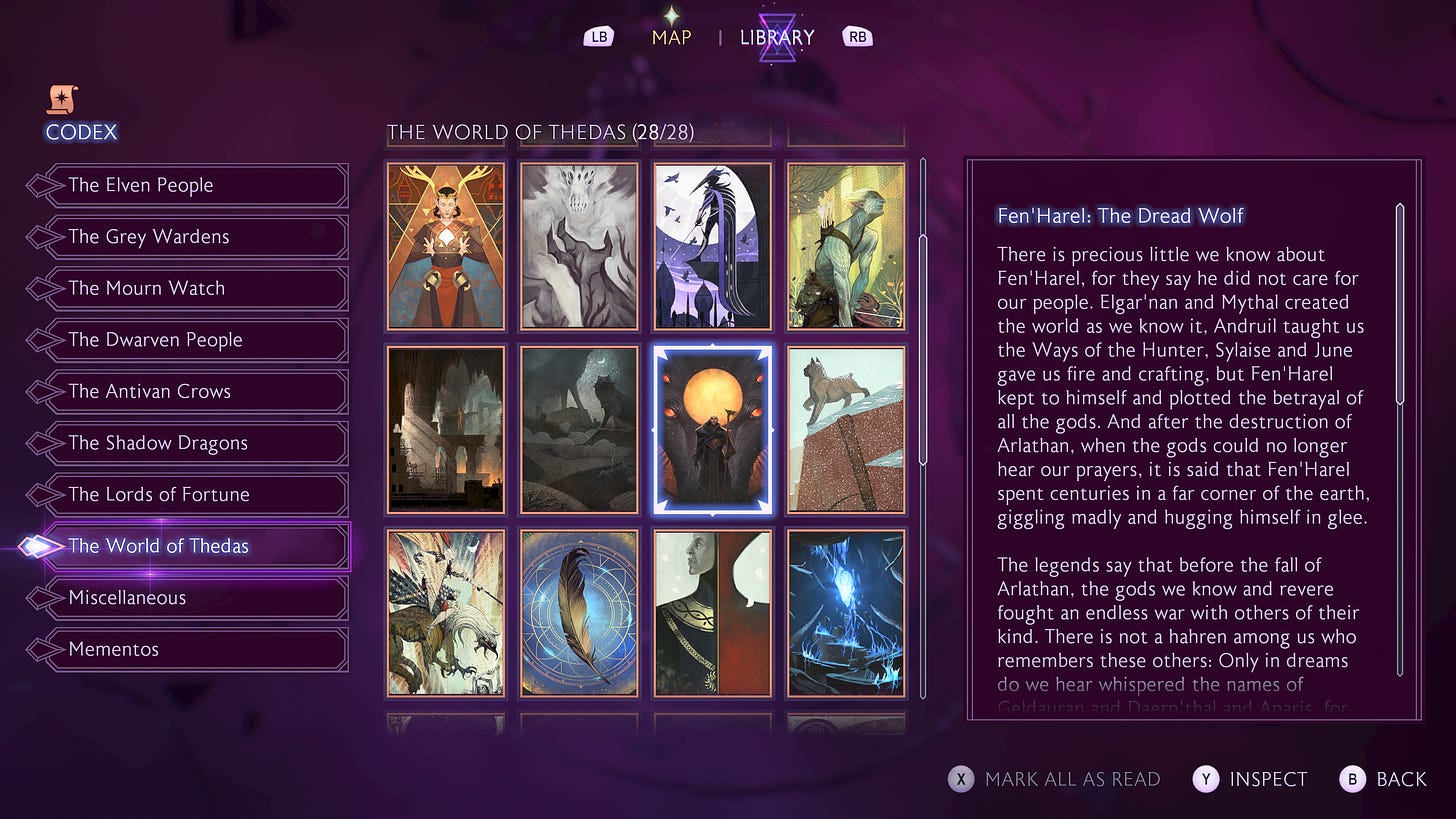
I’ve touched briefly upon the fact that I enjoyed the story and the quest design. The characters too were well fleshed-out and I found myself curious to learn more about them, and eager to guide them to the resolution of their personal crises. However, there is a caveat: The writing as a whole left me a little cold. Let me preface the next part by saying that I acknowledge that speech patterns and styles evolve over the years, and that the world that saw the launch of Origins 15 years ago is markedly different to the one we now inhabit. I get it. However, what I struggle to grasp is why clarity, conviction and (effective) communication had to be sacrificed at the altar of quippy and vapid writing for which the likes of Joss Whedon have plenty to answer. And that’s not all. When characters aren’t cracking wise like the increasingly tedious members of the Marvel Cinematic Universe, they’re often repeating themselves over and over.
Plot points and details about what the game wants you to do next are spelled out by NPCs on multiple occasions, and it gets to the point where you’re tempted to bludgeon them instead of the corrupted Elven gods or darkspawn. What makes all of this that much more bizarre is that it isn’t always like that. Every so often, the writers will dust off a heartfelt and insightful exchange between characters (particularly when you take certain companions out on a quest together), before sinking back into gloopy quip-laden mediocrity. And this is the biggest issue I have with The Veilguard as a whole.
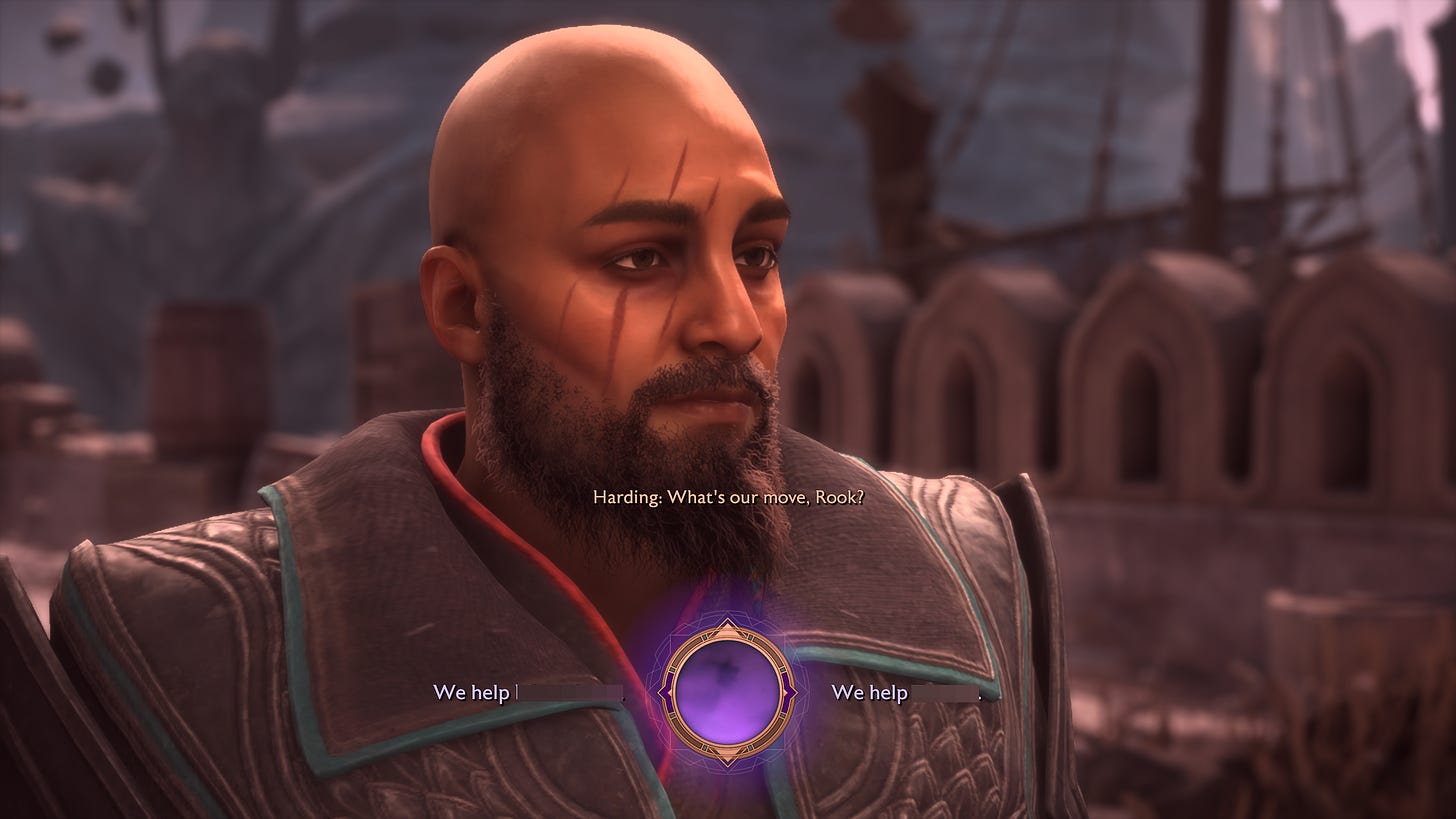
A slightly less grating issue I had was with the nature of choices and decisions that the game threw my way. Previous BioWare RPGs have found a way to include a mix of noble and ignoble options, allowing you to flavour your journey in rather more of an à la carte manner. With The Veilguard, I found that a majority of my dialogue choices were some variation of a ‘normal’ response to that situation. There were very few out-of-leftfield options that would let me flip the script, if only for a scene or two. Sure, the game does force you into a tiny number of seemingly impossible choices, but the outcome of at least two of those seems fairly reversible. All in all, even though the stakes of the actual story are higher than previous outings, my own agency as someone playing a role was annoyingly low-stakes. That said, it was made very clear by the devs that this was going to be a narratively linear affair, and so I was willing to look the other way on this one.
And one last little quibble. Among my favourite things to do in BioWare RPGs is to approach NPCs randomly and speak with them. Most often it’s a one- or two-liner delivered at me, sometimes there’s an exchange, and on the rare occasion, it’s actually a little conversation. This goes a long way in flavouring my entire journey. With The Veilguard though, it is clearly signposted when you can talk to NPCs and whether it’s just to hear them say something, have a conversation or discuss a quest that’ll be activated for you post-discussion. It’s manageable, but it does feel a bit inorganic given how accustomed I am to just wandering up to people and starting a conversation.
Onto something more positive, and I was quite pleased with the combat abilities of mages (particularly the Spellblade class that utilises a dagger for melee combat and staff for magic attacks) in this game. In past Dragon Age games, I’ve found this class to be quite underwhelming compared to the rogues or warriors. But not this time. My version of Rook packed a punch and half with his weapons and the ability to assign different elemental powers to each (for instance, fire for the staff and ice for the dagger) allowed me to round out the limitations posed by having only two companions.
Tying it all together
Maybe there was a plan at some stage for the fourth Dragon Age game to be a turn-based, open-world experience. And maybe at some point, a high-level decision was taken that a new direction was the need of the hour. For a studio with the sort of turn-based pedigree BioWare possesses, it certainly was disappointing to hear about the changed approach. However, having played through the game, my mind is changed. The combat system is fluid and mostly quite entertaining. Sure, it’s a different approach and requires a different mindset, but it works. Additionally, in the time since Inquisition, there’ve been a variety of outstanding turn-based titles. Atlus has honed their art when it comes to such games, and this year’s Metaphor: ReFantazio is the latest example. The team over at Ryu Ga Gotoku Studio has put its own twist on the genre and put out the extremely impressive Like a Dragon: Infinite Wealth this year. And last year’s smash hit Baldur’s Gate 3 remains the current gold standard for titles of this sort. The execs over at BioWare probably feel like they dodged a bullet by avoiding the format.
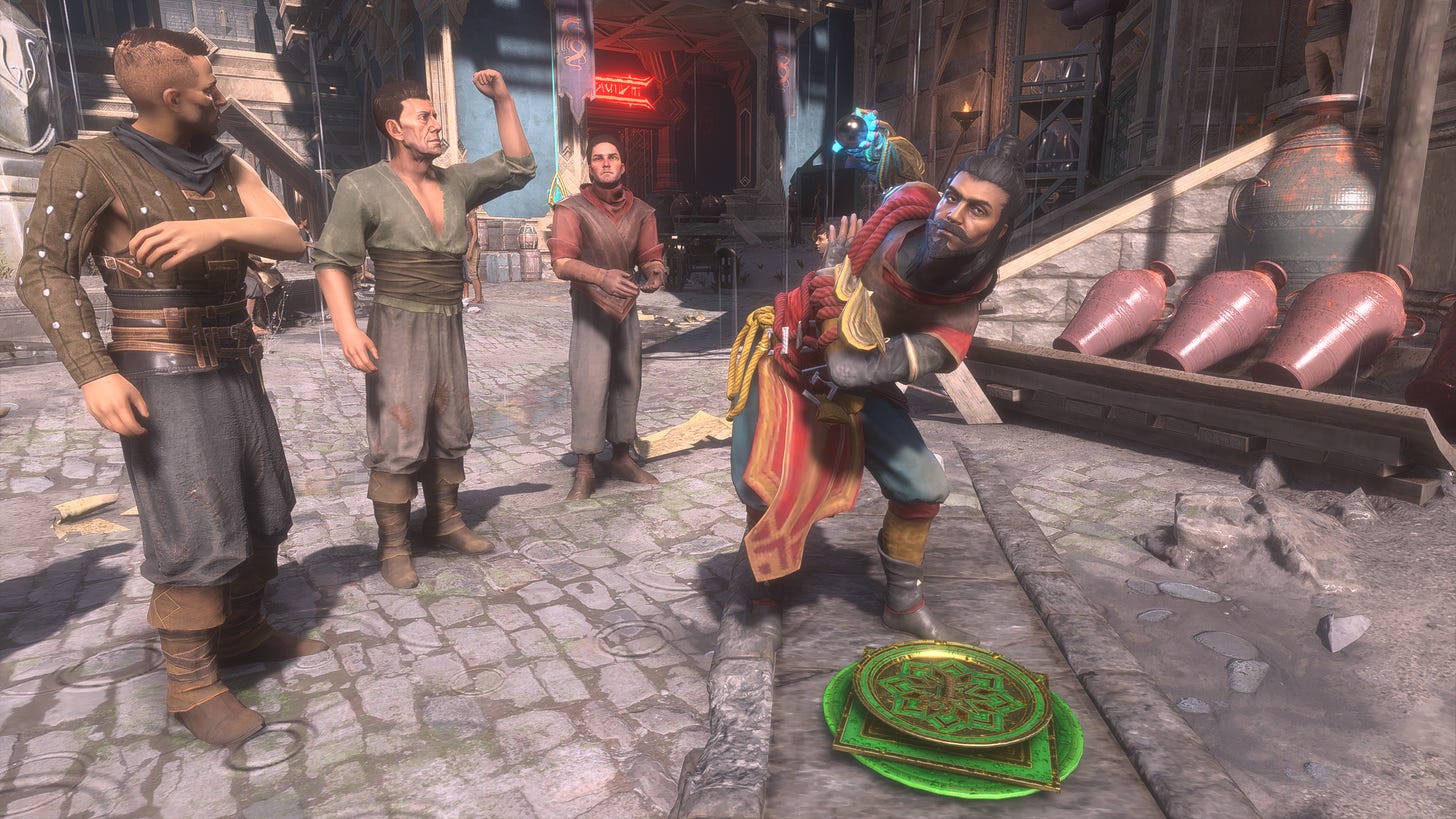
But on a deeper level, it felt to me like the studio reorienting/remaking its identity — a theme that was ever-present during my time playing The Veilguard. From the visual and combat styles to the writing, this is noticeable on the surface. However, scratch a little deeper and you’ll find that each of Rook’s companions is on a quest to either reorient or remake their own respective identities. One of them wants to figure out if they are more spirit than human, another wants to understand their sexual orientation and a third is questioning their faith in the Elvish gods, considering they’ve gone rogue. And then, you’ve got Solas, the Dreadwolf himself, also on something of a quest for identity. To some, it’s possible that a bunch of these journeys of self-discovery may come across as trite or hokey, but I enjoyed them as both a palate-cleanser from all the combat and a chance to get a deeper understanding of my companions and adversaries.
Perhaps what I found most impressive about all of it was that this felt like a game that was comfortable and confident in its skin. When you look back at all the bile, grift and hate (still befuddles me that people get so worked up about a videogame) that’s been — and continues to be — heaped all over the developer and publisher of this game, it’s quite a remarkable achievement. Was it perfect? Certainly not. Was it fun? Most definitely. Would I play it again? For sure. Do I recommend that you should play it? Immediately.
Game reviewed on Xbox Series X. Review code provided by publisher
Monsters with humanoid features, these are a recurring set of antagonists in the Dragon Age universe. The biggest threat they pose is their ability to infect other beings with a disease known as the Taint that transforms its victims into monstrous creatures.
A continent in the southern hemisphere (based on its geography) that is the only known landmass in the Dragon Age universe (see map)
These entail doing specific favours for your teammates to help you must complete a specific favour for them to sort out their mental state so that they're focused on the Mission.
The Dragon Age universe’s metaphysical world where people go when they dream. It is from the Fade that mages draw their magic, but this in turn attracts the attention of demons and monsters.





